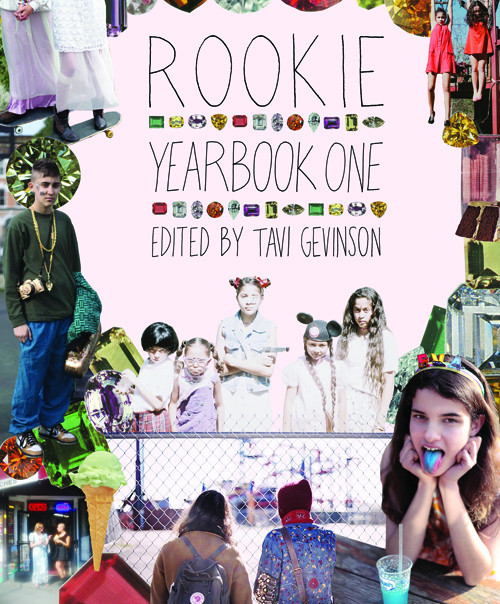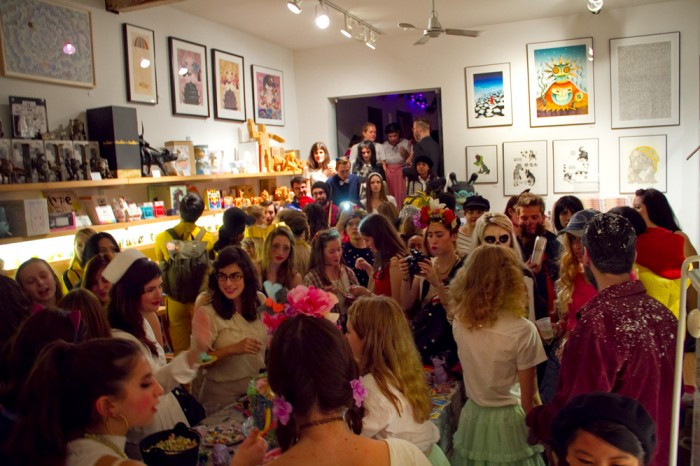In the Blog
Rookie Yearbook One and Book launch review
by Manisha Aggarwal-Schifellite and Michelle Kay
In late October this year, teen blogger and editor of Rookie magazine , Tavi Gevinson arrived in Toronto to celebrate the release of Rookie’s first print volume, Rookie Yearbook One. Gevinson was in town for two events: one a more traditional book reading and signing at Indigo Yorkdale, the second a book signing and masquerade ball at Magic Pony , an art gallery and store on Queen Street West.

http://rookiemag.com
The lineup for the dance party at Magic Pony featured girls of all ages and women. In line, you could hear teens oohing and aahing over the window display. They gushed over the little nook by the window filled with sparkles, pink items, cupcakes, strange dolls and other shiny things designed to draw in a teenaged girl’s eye.
Some people arrived in costumes, excited, wondering what it would be like to meet Gevinson, the teen wonder of the fashion world. Rookie, a kind of new millenium XOJane, has a monthly theme and its bloggers write about it, including personal essays and photospreads.
The book is a densely packed collection of favourite essays and interviews from the year, including many from Gevinson’s friends. She has no shortage of famous ones including Joss Whedon, Lena Dunham, Paul Feig, Miranda July, Jack Black and Aubrey Plaza, just to name a few. These celebrities offer advice to readers on navigating high school, blossoming romances, and indulging in your own uniqueness. The essays range from funny and silly to honest and candid, many of them reassuring readers and advising them to simply embrace who they are.
With the launch of Rookie, Gevinson has also become the face of a new kind of “girl power.” The Magic Pony event seemed to be as much a celebration of Rookie Yearbook One as it was a celebration of Gevinson herself. For the past three years, the 16-year-old has made a name for herself as a fashion blogger, writer, editor, stylist, and has become somewhat of an icon for a particular demographic of teen girls.
A general trend in reader response to Rookie emphasizes the idea that, as a fellow teen, Gevinson “gets it” when discussing sex, relationships, friendship, art, and general angst that come with being a teenager. In contrast to so much teen-focused content, Rookie has grown out of a “for us by us” mentality that resonates with its readers, complete with eye rolls and even a photo-guide by Gevinson on “How to Bitch-face.”
One of the most striking things about the Magic Pony event was the number of teenage girls who came to dance, buy books, eat candy, and meet each other. Some came in pairs from cities hours outside of Toronto to attend both events, while some downtowners came in big groups (And some even brought their parents). While some media outlets have called Rookie readers part of a new wave of “girl power,” Gevinson and the Rookie brand also appear to be introducing girls to feminism in a way that emphasizes positivity, friendship, and personal expression through clothes, books, movies, and other pop culture interests.

Photo from http://rookiemag.com/2012/10/masquerade-bal/ , provided to Rookie by Magic Pony, the event venue. Magic Pony via Rookie
When asked why they like Rookie and Gevinson, a common refrain among party attendees was that Rookie offered “something for everyone,” and that its inclusivity allowed girls to feel like they could be themselves without fear of judgment. Based on the Rookie party, and reading the Yearbook, Rookie seems to be everything to some people. Generally, the magazine speaks to and about a narrow teen demographic. Many of the contributors, celebrities and teens alike, appear to be from similar backgrounds–growing up in the suburbs, feeling like they didn’t fit in, and moving to a large city to pursue an entertainment-based dream.
Grounded in the aesthetically pleasing and fashion-focused elements of both the book and the launch party, it’s clear that Rookie’s approach to feminism is based on fun, friendship, and self-expression through fashion. Taking a fun approach to feminism gives it a wider appeal, but begs the question whether such this diminishes or ignores some of the necessary (and heavy topics) vital to feminism itself. In a recent Q interview, Gevinson said that Rookie is not “everything for everyone,” citing issues that contributed to a fairly narrow representation of teen life in Rookie Yearbook One.
Fun and creativity is presented through the DIY element of the magazine, website, and Gevinson’s personal blog, Style Rookie. While this can be a great way for girls to create their own media, “DIY” self-sufficiency and imagination are based in assumptions that erase the experiences of many teen girls who may not be able to identify with the Rookie brand. For instance, an article in the Yearbook teaches readers “How to go Thrifting.” The treatment of thrifting as an alternative to the mall (instead of being the only option for some people) speaks to the target demographic of the website. Further, Rookie’s photoshoots and DIY projects focus largely on decorating one’s room, collecting strange objects, and using these pieces as inspiration for personal style. This can only apply to someone who has their own room, with enough space to collect objects that represent her personality–this type of consumption focuses identity formation onto collecting “stuff” rather than “doing things.” While Rookie pushes for teens to find their own style and encourages teens to be themselves and not care what others think of them, it also promotes a kind of consumerism, a desire to be fashionable with an emphasis on customization, uniqueness and the collection of “cool” things. It ignores the fact that this is not a reality for every teen yet adeptly creates a desire for things without necessarily addressing how such consumerism could be problematic.
As one party-goer remarked, Rookie and Gevinson offers a good entry point to feminism for younger girls, many of whom might be unfamiliar with the movement’s history or current incarnations. Many of them may have negative associations with feminism as a concept, understanding the concept as a man-hating movement of angry lesbians who never have any fun. Rookie guides the reader into aspects of feminism and pointing out various forms of oppression (although it’s not called that on the website), other important components of feminism such as intersectionality and an analysis of race, gender identity, sexual orientation and class are not mentioned.
In spite of these important omissions, however, Rookie regularly publishes content on standing up for yourself, confronting sexism, dealing with bullying, and generally empowering yourself and others around you. In the Yearbook, Rookie authors speak eloquently about breakups (“Breakup Breakdown”), mixed-race identity (“On Containing Multitudes”), societal expectations and fears surrounding teen girls (“Season of the Witch”) and other issues that arise during and after adolescence. While reading these and other essays in the Yearbook, it really does feel as if the authors are speaking directly to the reader, which further emphasizes the community-building aspects of Rookie as a brand and a lifestyle.
Rookie’s growth and success over the past two years has taken an interesting trajectory–the magazine, under Gevinson’s editorial eye, has clearly been an important influence in the lives of teens across the world. As Gevinson’s ambitions change, and as the Rookie brand develops, the magazine could focus more on some of the issues missing from Yearbook One. It remains to be seen how this will happen, but the ever-changing nature of adolescence offers a good foundation for Rookie to expand its target demographic, as it solidifies its place as a mainstay of teen-driven media.



